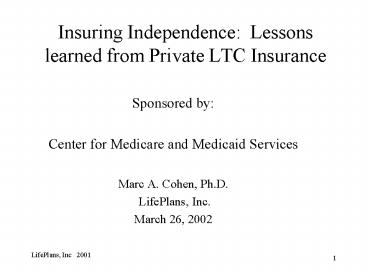Insuring Independence: Lessons learned from Private LTC Insurance PowerPoint PPT Presentation
1 / 19
Title: Insuring Independence: Lessons learned from Private LTC Insurance
1
Insuring Independence Lessons learned from
Private LTC Insurance
- Sponsored by
- Center for Medicare and Medicaid Services
- Marc A. Cohen, Ph.D.
- LifePlans, Inc.
- March 26, 2002
2
Purpose of Presentation
- To provide brief background on the private
long-term care (LTC) insurance market - Summarize experience of individuals receiving
benefits under their private LTC policies and
answer the following questions - How is family caregiving affected?
- Can claimants obtain adequate services?
- Do benefits help keep people in the community?
3
What are the Characteristics of the LTC Insurance
Market?
- The market is growing rapidly
- Individual Market 11 growth in sales (over
decade) - More than 7 million policies sold and about 4.0
million in-force. - Employer Market 32 growth in sales
- About 3,500 employers offer plans and 800,000
employees have coverage - Much competition 100 companies although top 20
account for more than 80 of market - Still, pays less than 10 of nations LTC bill.
4
Who is the Target Market?
- Middle to Upper Income Elders who would not
immediately qualify for Medicaid. - Somewhere between 25 and 35 of elders
- Those who may have few available informal
supports or who worry about not having them at
the time they may need LTC. - Younger adults who view LTC insurance as an
integral part of retirement planning. - Somewhere between 55 to 70 of age 40
5
Study
- Eight large LTC insurers contributed sample and
we interviewed about - 700 claimants receiving benefits in the community
- 500 claimants receiving benefits in assisted
living facilities or nursing homes - 425 family caregivers
- Sponsored by
- Office of the Assistant Secretary for Planning
and Evaluation Department of Health and Human
Services (ASPE) - Robert Wood Johnson Foundation Home Care Research
Initiative (RWJ)
6
Profile of Claimants in the Community
- Average age of 79
- 68 female
- 54 unmarried
- Average ADL limitations 3.3
- 30 are cognitively impaired
- 25 have as primary diagnosis stroke or CVA
- 85 have at least 2 or more ADL limitations or
are cognitively impaired
7
How is the Insurance Performing for Claimants in
the Community?
8
Average Monthly benefits from Private Insurance
are Relatively Generous
Note Medicaid figure from Ladd et al., 1999
9
Claimants are Satisfied with their Insurance
10
More weekly hours of care
11
Majority of family caregivers continue to provide
the same or more support
12
How the Nature of the Care Provided has Changed
in the Presence of LTC Insurance
- Less ADL Care
- Somewhat less IADL Care
- Greater companionship and meeting Expressive
Needs
13
Less Stress on CaregiversHow has presence of
insurance affected informal caregiver stress?
14
Ability to stay longer at homeIn the Absence of
Policy Institutional Care would be Sought?
15
Are the ADL and IADL Needs of Home Care Claimants
being Met?
- Unmet Need
- Do they think they need care that they are not
getting/using? - Undermet Need
- Do they have to wait too long to receive care?
- Do they receive care but not enough of it?
16
Extent to which claimants feel needs are being met
17
Key Observations
- Service availability, scheduling, continuity and
coordination of caregivers may all be important
factors that contribute to unmet and undermet
need issues. - Multiple caregivers
- Are responsibilities being clearly divided among
formal and informal caregivers? - Are different formal caregivers coming each time?
- Responsiveness of service delivery system
- Reluctance to use Services
- Also holds true in institutional settings
18
Do policy features affect levels of reported
unmet/undermet need?
- Policy benefits -- duration and level of
coverage -- have no effect - Policy design did make a difference The
Disability design (i.e. cash payment) is
associated with lower levels of unmet and
undermet need - Didnt appear that care management made a
distinct difference although difficult to isolate
potential independent impact.
19
Summary Observations
- Money isnt everything
- Financing is not sufficient to assure disabled
individuals needs are being met - Service delivery and provider issues are critical
to making money work for disabled person - There needs to be a developed service
infrastructure in place to enable care managers
to make a difference for clients - For most, insurance-financed formal care does not
replace family care. The two systems are
complementary and working hand-in-hand. - Private insurance is succeeding in enabling many
disabled claimants to remain in their homes.

